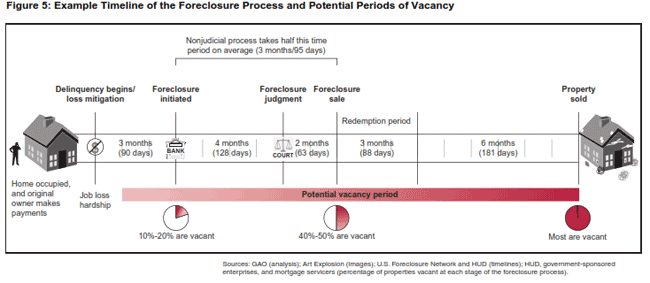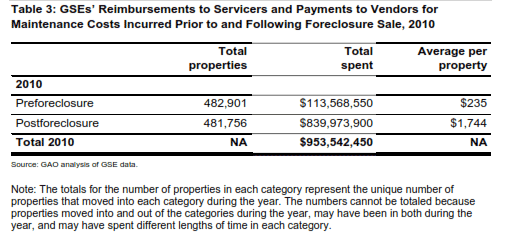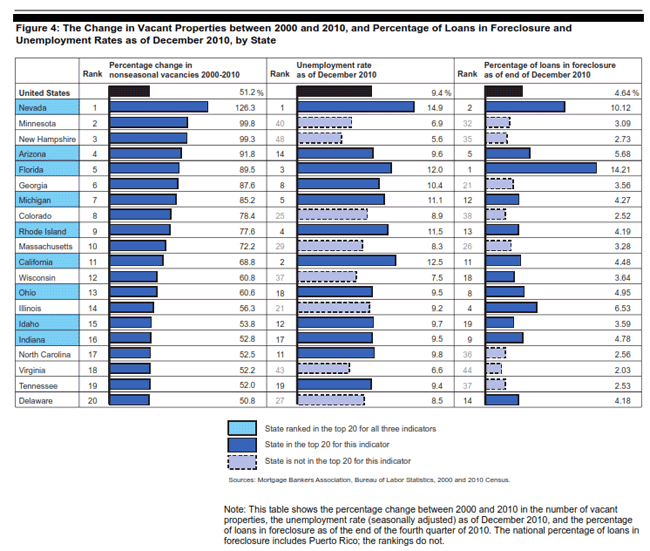Blog

Up 51% Since 2000, GAO Looks at Causes, Effects of Vacant Properties
The Census Bureau regularly issues arnvacant properties report which is generally covered by MND, and less extensiverndata on vacancies is kept by other government agencies – even the U.S. PostrnOffice. However there is no solidrnagreement about what constitutes a vacant property nor is there any way tornassess what may be a more or less benign vacancy such as a rental propertyrnmerely languishing between tenants or a seldom-used seasonal property and onernthat can become a neighborhood blight, attract crime, and pose a threat tornpublic safety. </p
Whilernhomeowners or mortgage owners–including the mortgage servicers that administerrnloans on behalf of loan owners–are responsible for maintaining vacantrnproperties where mortgages are undergoing foreclosure, the costs localrngovernments incur to mitigate any unsafe conditions can be significant. </p
According to the Census Bureau,rnnon-seasonal vacant properties have increased 51 percent nationally from aboutrn7 million in 2000 to 10 million in April 2010. rnTen states saw increased vacancies of 70 percent or more. With the incidence of vacant residentialrnproperties rising, the Government Accountability Office (GAO) was asked tornconduct a study to determine the relationship between trends in vacancies andrnthe recent increase in foreclosure. rnUsing data from the Federal Housing Administration (FHA), the tworngovernment sponsored enterprises (GSEs) and the Census Bureau, GAO looked atrnthe costs accruing to vacant properties, who is responsible for those costs,rnvarious state and local government strategies to deal with the problem and howrnthe federal government might assist in their efforts.</p
GAO found a number of causes for thernincreased vacancies. Some cities had bigrnpopulation shifts even before 2000 as manufacturing and other jobs disappeared. These cities have been joined by many othersrnas unemployment has risen nationally; people have moved to other locations inrnsearch of jobs, moved in with friends or relatives to save money or lost theirrnhomes to foreclosure. The correlationrnamong vacancies, unemployment, and foreclosure can be seen in the followingrntable.</p
GAO found that the longer a foreclosurerntakes to complete, the greater the impact on the vacancy rate. Homeowners may misunderstand their rightsrnunder a foreclosure and move out long before they are legally required to do sornor just become disheartened by the process. rnA Federal Reserve study found that homeowners tend to leave their homesrnearlier in the process in non-judicial foreclosure states than in judicialrnstates. </p
 </p
</p
Foreclosed homes tend to remain vacantrnfor long periods after a foreclosure sale as well. One study found that homes foreclosed by HUDrnin 2010 remained in REO for 181 days before being sold. Another found a house sold through arnforeclosure sale in Cuyahoga County, Ohio was more likely to be vacant 60rnmonths later than a home sold via an ordinary transaction.</p
Another factor leading to vacancies isrnthe lower demand for housing in general. Persons who would typically be in the marketrnfor housing may be unemployed or otherwise unable to afford it or unable tornobtain the necessary credit. In somernparts of the country households are forming at historically low rates.</p
Regardless of how or why a propertyrnbecomes vacant, it needs to be maintained. rnCommunities have a code of standards for property to ensure health andrnsafety and communities generally enforce the code with fines and can, ifrnnecessary, secure a building, remove hazards, even demolish the structure andrnbill the owner. But an owner who hasrnabandoned his home is probably unwilling or unable to pay for furtherrnmaintenance even if located and, while mortgage documents give the lender thernright to enter, maintain, and secure the property, they do not confer anrnobligation to do so.</p
FHA and the GSEs have standards forrntheir services regarding inspection and maintenance of vacant properties andrnservicers for privately owned loans are supposedly guided by the pool andrnservicing agreements for those loans.</p
Servicers incur various costs tornmaintain properties in lieu of homeowners doing so and the owner or insurer ofrnthe loans typically reimburses servicers for those expenses. The tables below show the propertyrnmaintenance costs for which the GSEs reimbursed servicers in 2010 and thernpurposes for which those funds were expended. rnFHA requires a higher standard of attention and its per property expensernprior to conveyance to FHA in 2010 was $1,982. After conveyance FHA turns responsibility forrnproperty maintenance over to private contractors to whom they paid a total ofrn$38 million or $234 per property in 2010.</p
 </p
</p
When the legally responsible parties dornnot maintain their properties sufficiently to comply with local codes or publicrnsafety standards local governments spend millions in direct costs to mitigaternthe resulting problems. GAO cited arnrecent Chicago study that found that 69 percent of over 18,000 vacantrnproperties in the city were associated with a foreclosure filed in thernpreceding four years. For manyrnproperties the responsibility was unclear and the city likely had to incur therncost of any work. </p
Among the issues local communities have to contendrnwith are:</p
Exterior Maintenance. Reducing the negative or hazardous impact ofrnvacant properties by boarding up and securing them can cost between $233 andrn$1,400. Chicago officials estimated thatrnit cost them $785,000 to board up 627 properties in 2010. Detroit estimated they had spent $1.4 millionrnboarding up 6,000 properties in the last year. rn</p
Demolition of vacant buildings is anotherrnsignificant expense. Demolishing arndetached single-family home costs $4,800 to $7,000 per property but thernpresence of lead paint or asbestos can drive the cost much higher. Detroit has spent about $20 million inrndemolitions since May 2009, $5,000 per property. In Baltimore where many homes are row housesrnwith common walls, the costs to raze a single row house could be $13,000 torn$40,000.</p
Administrative and Judicial Costs. Local governments also bear the costs ofrnidentifying responsible parties against whom to levee code violation fines orrnliens and cities such as Chicago that have housing courts spend additionalrnresources on enforcing laws governing vacant properties through therncourts. Cleveland is said to spend $3rnmillion a year on housing court costs for vacant properties.</p
Vacant properties have other costs which arerndifficult to quantify but burden the community. rnThere are increased public safety costs related to code-enforcement,rnpolice, and fire services. Onerncode-enforcement officer in Las Vegas told GAO that they have four to fiverncalls per month on vacant property issues. Some academic studies also have foundrnrelationships between vacant or foreclosed properties and crime. Vandalism can occur quickly, homes are strippedrnof copper pipes, wiring, AC units and appliances. Squatters in properties without heat orrnelectricity cause fires with alternative energy sources or candles. Even buildings being maintained by servicersrncan develop problems between inspections. rn</p
Vacantrnproperties also reduce the value of houses around them. One federal study estimated a foreclosed homerncan depress the prices of nearby homes from 0.9 to 8.7 percent. Another study in Chicago found that a singlernforeclosed and demolished property may have reduced the value of 13 nearbyrnhomes by $17,000 each.</p
Decliningrnproperty values and unpaid taxes on vacant properties lead to reduced revenuesrnfor local governments. Local propertyrntax revenues declined nationally by 2 percent in 2010 compared to 2009 andrnlikely will decline further in the next few years as assessments are adjustedrnto reflect falling property values. rnFurther, these declining values means that local governments willrncollect less money on properties they seize and sell for unpaid taxes.</p
Localrngovernments throughout the country are developing strategies to manage thernproblems associated with vacant buildings. rnGAO identified some common themes.</p
InrnDepth Data Gathering. This includes compiling and analyzing datarnfrom existing sources such as city departments, courts, and registries torndetermine where vacant or potentially vacant properties are located; leveragingrnresources from local universities and research organizations to acquire social,rndemographic and property data, and collecting new data.</p
PropertyrnAcquisition and Development Strategies. rnEight of the nine cities GAO studied were engaged in actively acquiringrnvacant properties, often with federal funds. rnTypically these are acquired at foreclosure then turned over to arncommunity organization for rehabilitation and use or resale. These efforts can stabilize a neighborhoodrnbetter than home purchases by investors who may flip and run without doing allrnof the repairs necessary. They alsornallow the local government to target its efforts, perhaps investing in an arearnthat has strengths to bolster the property.</p
Whilernmany view acquisition and rehabilitation as a strong strategy to combat thernproblems of vacant properties, there are problems such as lack of the capacityrnto complete sales quickly or complete enough of them, poor property conditions,rnand the large volume of foreclosures each of which can complicate efforts atrnthe local level. </p
Somerncommunities are unable to sell properties in the current market and haverninstead established land banks to hold properties for extended periods and thenrnreuse them in non-housing contexts. rnCuyahoga County for example has an agreement with Fannie Mae where itsrnland bank receives all of the GSEs low-value properties for $1 and Fannie Maerncontributes about $3,500 per property toward demolition costs.</p
Laws,rnLocal Ordinances and Dedicated Housing Courts are Utilized d to IncreasernAccountability for Vacant Properties. Withrnthe increase of vacant properties in many communities, local governments arernpassing stronger maintenance requirements and property registration ordinancesrnto increase their leverage over servicers and using local resources to enforcernthem. </p
GAOrnfound that many local governments were overburdened by the vacant homes inrntheir jurisdiction and most wanted the federal government to help with therncosts they were incurring but also to increase oversightrnof loan servicers to ensure that they comply with local property maintenancerncodes.
All Content Copyright © 2003 – 2009 Brown House Media, Inc. All Rights Reserved.nReproduction in any form without permission of MortgageNewsDaily.com is prohibited.
Latest Articles
By John Gittelsohn August 24, 2020, 4:00 AM PDT Some of the largest real estate investors are walking away from Read More...
Late-Stage Delinquencies are SurgingAug 21 2020, 11:59AM Like the report from Black Knight earlier today, the second quarter National Delinquency Survey from the Read More...
Published by the Federal Reserve Bank of San FranciscoIt was recently published by the Federal Reserve Bank of San Francisco, which is about as official as you can Read More...


Comments
Leave a Comment